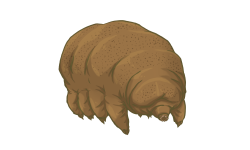
Two thousand years ago, the Roman historian Tacticus said that “victory is claimed by all, failure to one alone.” Such is the fate of successful creative works, whether they are music, art, or television shows. In recent years, the Star Trek universe has expanded to include several new shows, including the successful Star Trek: Discovery. Enter the copyright infringement lawsuits.
Anas Abdin created a videogame over the course of several years between 2014 and 2017. The video game is set in 20,000 B.C., and focuses on characters living on a space station. In 2015, he created a character based upon a very hardy microorganism called a “tardigrade”. Mr. Abdin posted draft designs and descriptions on two websites, and created YouTube videos discussing the game, but never released the game. Star Trek: Discovery aired in September 2017 and also included a tardigrade character. Mr. Abdin obtained a copyright registration for a distillation of the game concept in June 2018, and then sued CBS Broadcasting and other defendants for copyright infringement. The district court granted the defendants’ motion to dismiss the case, and the plaintiff appealed.
On August 17, 2020, the 2nd U.S. Circuit Court of Appeals affirmed a lower court’s ruling in Abdin v. CBS Broadcasting, Inc., et al., denying Abdin’s copyright infringement claims. As the court so eloquently put it (emphasis added),
Today, in the latest round of Star Trek-related litigation, we are asked to boldly go where no court has gone before and determine whether the television series Star Trek: Discovery… unlawfully infringed upon a game developer’s videogame concept involving a tardigrade, a real life microscopic organism with the unique ability to survive in space.
Judge Chin’s 38-page opinion spends an impressive amount of time discussing Star Trek, the Star Trek universe, and Star Trek: Discovery. While Judge Chin would seem to be a science fiction fan, the opinion unfortunately contains spoilers for those who have not yet watched Star Trek: Discovery. The court also addressed Abdin’s concept art, unreleased video game, and blogs.
So, what exactly is a tardigrade? The district court looked to the Merriam-Webster Dictionary’s definition: “any of a phylum (Tardigrada) of microscopic invertebrates with four pairs of stout legs that live usually in water or damp moss – called also water bear.” They are extremely hardy, able to go into a dormant state for up to a year when faced with extreme conditions. As the court noted, “Both the Videogame and the Television Series include a large tardigrade that can fly through space and interacts with the characters. These concepts are not original to the Videogame. Since at least 2007, Tardigrades have been identified as the first known animal to survive unprotected in outer space.” The court also cited various other works incorporating tardigrades and examined the use of the tardigrade character in the plaintiff’s video game and in Star Trek: Discovery.
The plots of both works are similar solely to the extent that the characters go on adventures in space, and some of the adventures involve alien tardigrades. This common storyline of adventuring through space and discovering aliens is a Scènes à faire common to works that involve space travel. Just as ‘cowboys, bank robbers, and shootouts in stories of the American West . . . get no protection,’ alien contact in fictional stories about space adventures gets no protection.
The court analyzed the characters’ similarity by examining their attributes and traits, and the extent to which they captured the “total concept and feel” of other characters in the author’s work. The court noted that the inherent physical characteristics of a tardigrade are not protectable by copyright, and that the look of the tardigrade in Star Trek: Discovery, and its relationship to the show’s plot and characters, are quite different from Abdin’s use. The court found that the plaintiff had not overcome the high bar to prove the substantial similarity of the characters, and it affirmed the lower court’s dismissal of Abdin’s case.
For 50 years, litigants have brought Star Trek-related intellectual property lawsuits, but this may be the first one which involved microscopic space creatures. As Spock said, “the needs of the many outweigh the needs of the few.” We are all free to create our own works involving tardigrades. Here’s one: a space western involving an evil master of dark forces, a likable hired gun, a naive farm boy, a princess who needs to be rescued… And a tardigrade.
–Joshua D. Waterston, Esq.
*Originally posted on September 3, 2020

